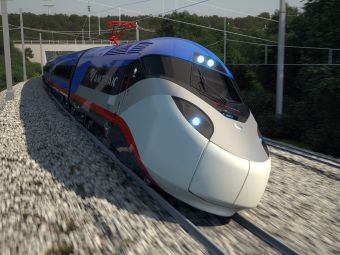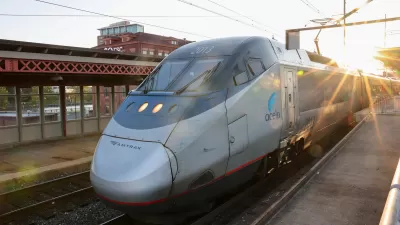Amtrak will replace, rather than overhaul, aging Acela trains with new, 186-mph trains from French manufacturer, Alstom, though they won't exceed 160 mph. The agreement was announced Friday by VP Joe Biden at Biden Station, Wilmington, Del.

"This loan is a key step to providing investments needed to help keep high speed trains moving throughout the region, and to help all commuters in the Northeast Corridor," Vice President Biden said. "We need these kinds of investments to keep this region – and our whole country – moving, and to create new jobs."
It is the largest loan made by the U.S. Department of Transportation, financed through the Federal Rail Administration's Railroad Rehabilitation & Improvement Financing program.
The trains are named "Avelia Liberty, the latest development of Alstom’s high-speed train range Avelia," according to Alstom. "The new trainset will be able to carry up to 33% more passengers than the current Acela trains."
Another key feature is the train’s articulated architecture, which provides greater stability and passenger comfort while enhancing safety. The train also includes Alstom’s innovative Tiltronix anticipative tilting technology, which allows the train to manoeuvre curves safely and more comfortably at high speeds.
"Officials said about $2 billion would be spent on the new trains," reports Michael D. Shear, White House correspondent for The New York Times. "The rest of the loan will be used to upgrade several stations, including those in New York and Washington, and to improve track reliability and safety."
Anthony R. Coscia, Amtrak’s chairman, said the railroad service was “responding to a change in the United States of people moving into the cities, of people looking for city-to-city connections.”
The trains will be manufactured at Alstom's Hornell, N.Y plant, which comes as "no surprise," reports William C. Vantuono, Editor-in-Chief for Railway Age, due to Sen. Chuck Schumer’s (D-N.Y.) very public visit [there] on Sept. 21, 2015. Vantuono adds that station and track improvements "will benefit both Acela Express riders and other Amtrak and regional commuter rail passengers."
"Amtrak plans to put the first of 28 new trains into service in about five years," adds Shear.
Once they are fully deployed, officials expect the Acela to depart every half-hour between Washington and New York and every hour between New York and Boston. That should increase passenger capacity by about 40 percent, they said. Amtrak expects increased revenue from the more frequent Acela service to help it pay back the loan.
The Acela trains have become one of the most successful parts of the Amtrak system. Over the last decade, they have helped train service displace airplanes as the most popular mode of travel in the Northeast Corridor. Acela trains carry about 3.4 million passengers a year between the three major cities.
Hat tip to Mark Boshnack.
FULL STORY: Amtrak’s Answer for Aging Acela Fleet: 160 M.P.H. Trains

Maui's Vacation Rental Debate Turns Ugly
Verbal attacks, misinformation campaigns and fistfights plague a high-stakes debate to convert thousands of vacation rentals into long-term housing.

Planetizen Federal Action Tracker
A weekly monitor of how Trump’s orders and actions are impacting planners and planning in America.

In Urban Planning, AI Prompting Could be the New Design Thinking
Creativity has long been key to great urban design. What if we see AI as our new creative partner?

King County Supportive Housing Program Offers Hope for Unhoused Residents
The county is taking a ‘Housing First’ approach that prioritizes getting people into housing, then offering wraparound supportive services.

Researchers Use AI to Get Clearer Picture of US Housing
Analysts are using artificial intelligence to supercharge their research by allowing them to comb through data faster. Though these AI tools can be error prone, they save time and housing researchers are optimistic about the future.

Making Shared Micromobility More Inclusive
Cities and shared mobility system operators can do more to include people with disabilities in planning and operations, per a new report.
Urban Design for Planners 1: Software Tools
This six-course series explores essential urban design concepts using open source software and equips planners with the tools they need to participate fully in the urban design process.
Planning for Universal Design
Learn the tools for implementing Universal Design in planning regulations.
planning NEXT
Appalachian Highlands Housing Partners
Mpact (founded as Rail~Volution)
City of Camden Redevelopment Agency
City of Astoria
City of Portland
City of Laramie




























